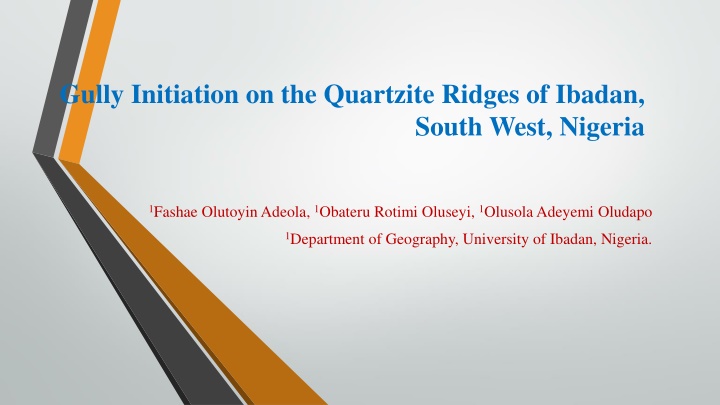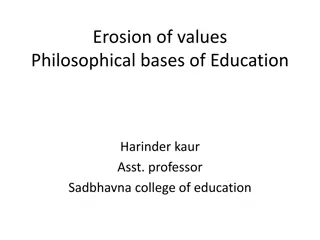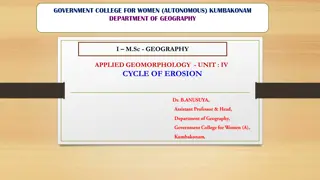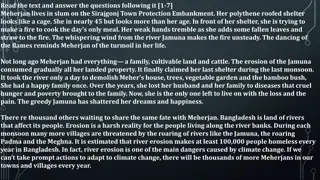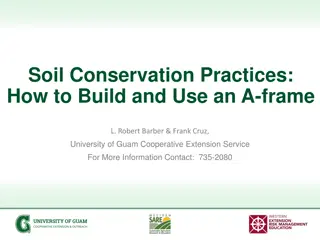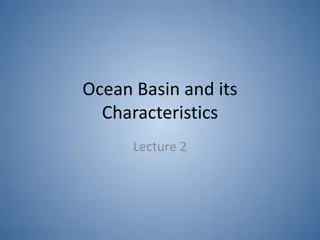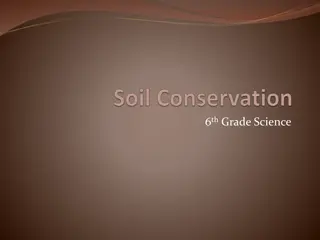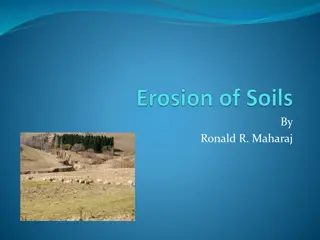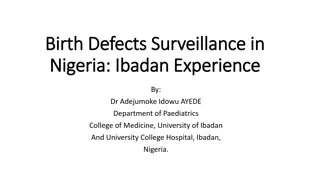Gully Erosion Studies in Ibadan, Nigeria: Quartzite Ridges Assessment
This study focuses on gully erosion initiation and development on the quartzite ridges of Ibadan, Nigeria. It explores the morphological characteristics of gullies, factors influencing gully formation, and their relationship with gully morphology. The research highlights the importance of understanding gully erosion processes in basement complex areas like Ibadan. Various studies and examinations of gullies in Nigeria's sedimentary and basement complex terrains are discussed, emphasizing the significance of assessing gully erosion on quartzite ridges.
Download Presentation

Please find below an Image/Link to download the presentation.
The content on the website is provided AS IS for your information and personal use only. It may not be sold, licensed, or shared on other websites without obtaining consent from the author.If you encounter any issues during the download, it is possible that the publisher has removed the file from their server.
You are allowed to download the files provided on this website for personal or commercial use, subject to the condition that they are used lawfully. All files are the property of their respective owners.
The content on the website is provided AS IS for your information and personal use only. It may not be sold, licensed, or shared on other websites without obtaining consent from the author.
E N D
Presentation Transcript
Gully Initiation on the Quartzite Ridges of Ibadan, South West, Nigeria 1Fashae OlutoyinAdeola, 1Obateru Rotimi Oluseyi, 1Olusola Adeyemi Oludapo 1Department of Geography, University of Ibadan, Nigeria.
INTRODUCTION Patton and Schumm, 1975; Imesonand Kwaad, 1980; Poesenet al. 2003-Gullies occur when a geomorphologic threshold is exceeded. Schumm et al. (1974) ,Poesen et al. (2002), Zhu, 2012, Vendrusculo, 2014, Menendez-Duartz et al., Kumar et al. (2020), Poesen (1993) reveals it occurs in several climes, caused by several factors with varying characteristics. And so many other definitions .. But all definitions point to the fact that Gullies are characterized by: 1. Depressions greater than rills . 2. Their development is initiated by the action of concentrated overland flow on soil materials.
GULLY EROSION STUDIES FROM NIGERIA Okagbueand Uma, 1987)-Examined the different dimensions/forms of Gullies on the Southeastern sedimentary basin. Several other studies (Ofomata, 1965; Nwajide and Hoque, 1979; Henry et al. 2016) Affirmed the role of soil and geology on the process of gully evolution, still in the SE sedimentary basin. Adediji, et al. (2013), Faniran and Areola, 1974; Conforti, et al. 2011-concluded that human activities are responsible for gully initiation and acceleration on the basement complex terrains of southwestern regions.
Why study Gully erosion on the Basement complex of Nigeria Gullying processes on the sedimentary terrain have received significant attention from researchers while such processes are often overlooked in the Basement Complex areas because of their perceived resistance to denudation.
Aim and Objectives Aim Assess the development and the initiation of gully erosion on the quartzite ridges of Ibadan, Nigeria. Objectives : assess the morphological characteristics of gullies on the quartzite ridges, and examine the factors of gully development on the ridges and their relationship with gully morphology.
Study area The study sites are Mokola ridge, Mapo ridge and Eleyele Hill All in Ibadan. The geomorphology of Ibadan consists of HILLS, PLAINS & VALLEYS. Rainfall- Elevation -174 m and 365 m above sea level Ibadan is underlained by Basement Complex rocks which mainly consist of the metamorphic rock types of Pre-Cambrian age, but with some intrusions of granites and porphyrite of Jurassic age. The Hills / Ridges are Quartzitic with intrusions of some schist.
Field Measurement Gully length, width & depth were measured at an interval of 5 metres with a measuring tape Gully slope was measured using abney level and ranging poles. Soil samples at depth 0 15 cm was collected from each gully section using soil auger and core sampler. Soil samples were kept in opaque cellophane bags to preserve their original properties while they are being transported to the laboratory for analyses. Photographic shots and coordinates of the gullies would be obtained using digital camera and Global Positioning System (GPS).
Morphological characterization Derived variables Formulae Cross-sectional area (Ehiorobo andAudu, 2012) ? = (? + ?. ) Where, A = gully cross-sectional area, h = depth of gully, b = gully breadth, and s = side slope Gully Volume/Soil loss (VL) ??=? Where, Where, VL= volume of soil loss between the sections; A1= cross-sectional area of the first section; A2= cross- sectional area of the second section; and Am= cross-sectional area of section mid-way between first and second sections. (Schoffield, 1993) 6?1+ 4??+ ?2 Gully density (D) ? =????? ????? (Gawrysiak L, Harasimiuk, 2012) ???? Gully frequency (F) ? =??.?? ??????? (Gawrysiak and Harasimiuk, ???? 2012) Gully shape 2? ???? (?????????)2 (Xu et al. 2012) ????? ? ??? =
Laboratory and Statistical Analyses The soil samples were analyzed in the laboratory for pH, Electrical conductivity (EC), organic matter (OM), sodium absorption ratio (SAR), and exchangeable sodium percentage (ESP) using standard laboratory procedures. Spearman Rank Correlation was used to infer the relationship between variables.
Table 1. Characterization of Gully Systems on Quartzite Ridges in Ibadan Gully System Gully Site Altitude (m) Wmax(m) Wav Dmax (m) Dav (m) L (m) Straight Length Wb (m) Order (m) (m) Mokola Hill Mk 1 235.60 2.76 2.03 1.74 1.18 39.40 31.50 0.60 1 Mk 2 241.20 1.21 0.82 0.96 0.85 5.98 5.71 0.71 1 244.10 0.91 0.51 0.91 0.75 5.20 4.20 0.42 1 246.70 8.30 5.70 1.60 1.56 10.10 9.60 5.20 2 Mk 3 221.70 5.12 4.52 2.40 2.2 13.90 12.80 2.47 1 237.60 1.71 1.64 1.66 1.62 24.80 22.70 1.60 1 213.70 5.70 5.50 3.12 2.95 48.30 38.70 4.90 2 Mk 4 234.40 4.90 4.85 1.21 1.1 40.50 37.90 5.40 2 Mk 5 241.10 6.23 5.70 2.24 1.93 50.20 39.40 3.30 1 192.20 26.40 25.3 8.16 7.15 29.20 26.10 23.40 2 224.80 3.88 3.62 5.52 4.8 50.20 49.40 0.98 3 Mapo Ridge KB 1 197.30 2.80 2.57 1.40 1.2 39.59 27.30 2.23 1 2.20 2.10 1.34 1.26 2.10 1.90 1.80 2 5.41 5.87 1.85 1.6 80.23 72.62 1.62 1 KB 2 187.50 4.27 4.11 1.30 1.1 10.36 9.54 4.01 1 3.45 3.21 3.48 3.32 18.10 13.20 2.90 2 7.25 6.42 3.75 3.42 65.69 58.21 6.20 1 30.10 29.00 2.10 2 8.87 6.12 28.10 1 ID 1 133.70 2.41 2.31 1.30 0.9 26.80 18.60 2.11 1 2.49 2.32 0.91 0.9 58.10 32.60 2.20 2 6.09 5.88 3.30 3 19.80 14.20 5.70 2 Eleyele Hill EL 1 190.30 1.86 1.73 1.56 1.4 37.91 41.70 0.84 1 EL 2 191.60 2.04 1.40 1.65 1.43 82.00 83.40 0.65 1
Figure 3. Soil textural composition, pH & Exchangeable acidity of the gully systems
Figure 4. Organic matter, electrical conductivity (EC), sodium absorption ratio (SAR) & exchangeable sodium percentage (ESP).
Factors of Gully Development Topography Gentle sloping concave valley side of the ridge. Lineament lines of weakness Soil properties Sodic composition (SAR & ESP) and high EC. Land use Improper land use, footpaths, bush burning, farming, construction.
Relationship between morphology and gully development The relationship between topography and gully development was asserted by identifying the degree of association between hill slope elevation and gully width/depth ratio. Correlation analysis returned a negative coefficient of r = -0.462 (p < 0.05). Therefore, there is an inverse relationship between the altitude and gully development. The occurrence of the gullies on gentle slopes of the ridges is supported by the findings of Le Roux and Sumner (2012); Tamene et al. (2006); Kakembo et al. (2009) SAR (r = 0.794) and ESP (r = 0.867) are positively correlated with gully cross-sectional area (p < 0.05). Organic matter content and electrical conductivity are not statistically significant (p > 0.05). Similarly, strong positive relationship was observed between SAR (r = 0.758, p < 0.05), ESP (r = 0.661, p < 0.05) and gully volume at 0.05 level of significance. This suggests that sodic rich mineral content of the parent material of the gully systems exact strong influence on the process of gully development. This inference is in line with previous researches conducted by Poesen et al. (2002), Romero Diaz et al. (2007) and Samani et al. (2008).
Relationship between morphology and gully development cont d From the results, we posit that gullies formed on gentle slopes are usually characterised by wide and U-shaped channels. These gullies are largely discontinuous, not too deep, and their slope ranges between 30-70. Whereas, the gullies on the steep slope (150- 300) are crusted with bedrocks that are characterisedby deep and narrow channels. The relationship between SAR and ESP suggests that sodic soils encourage gully initiation.This implies that gully initiation processes are dominant on gently sloping terrain due to the availability of large surface area and weathered regolith that will enhance fluvial processes of material detachment on the one hand and subsurface processes like piping on the other hand.
CONCLUSION As observed from the study, topography, lineament, soil properties and human activities encouragethe initiation anddevelopment ofthegullies. Also, the study concluded that the presence of excessive amounts of exchangeable sodium reverses the process of compaction and causes soil aggregates to disperse into their constituent individual soilparticles. And finally, further geomorphological assessment of landform units in Ibadan is necessary with a view of identifying potential geomorphic risk prone areas, an essential component of risk management of the dense urban areas of the humid tropics.
REFERENCES Ehiorobo, J.O. & Audu, H.A.P. (2012). Monitoring of Gully Erosion in an Urban Area Using Geoinformation Technology. Journal of Emerging Trends in Engineering and Applied Sciences (JETEAS) 3 (2): 270-275 Gawrysiak, L. & Harasimiuk, M. (2012). Spatial diversity of gully density of the Lublin Upland and Roztocze Hills (SE Poland). Ann UMCS 67:27 43. Kakembo, V., Xanga, W.W. & Rowntree, K. (2009). Topographic thresholds in gully development on the hillslopes of communal areas in Ngqushwa Local Municipality, Eastern Cape, South Africa. Geomorphology 110: 188 194. Le Roux, J. J. & Sumner, P. D. (2012). Factors controlling gully development: comparing continuous and discontinuous gullies. Land Degradation & Development, 23(5), 440-449. Men ndez-Duarte, R. Marqu nez, J. Fern ndez-Men ndez, S. & Santos, R. (2007). Incised channels and gully erosion in Northern Iberian Peninsula: Controls and geomorphic setting. Catena, 71(2), 267-278 Poesen, J. Vandekerckhove, L. Nachtergaele, J. Oostwoud Wijdenes, D. Verstraeten, G. van Wesemael, B. (2002). Gully erosion in dryland environments. In: Bull, L.J. Kirkby, M.J. (Eds.), Dryland Rivers: Hydrology and Geomorphology of Semi-Arid Channels. Wiley, Chichester, UK, pp. 229 262. Romero Diaz, A. P. Marin Sanleandro, A. Sanchez Soriano, F. Belmonte Serrato, H. Faulkner, (2007). The causes of piping in a set of abandoned agricultural terraces in southeast Spain. Catena 69, 282-293. Rowntree, K.M. (1991) Morphological characteristics of gully networks and their relationship to Host Materials, Baringo District, Kenya. GeoJournal 23.1 19-27. Samani, A.A. Nazari, H. Ahmadi, M. Jafari, J. Ghoddousi (2008). Effect of incipient gullying mechanisms on topographic threshold conditions for gully initiation in southwestern Iran (Boushehr-Samal watershed). DESERT 13 (2008) 31-43 Schoffield, W. (1993). Engineering Surveying. Butterworth Heineman Ltd, Oxford U.K Tamene, L., Park, S.J., Dikau, R. & Vlek, P.L.G. (2006). Analysis of factors determining sediment yield variability in the highlands of northern Ethiopia. Geomorphology 76: 76 91. Xu, Z., Fachao, Q., Bin, Z., Qingchun, D., Hui, L., Jie, J., & Liangtao, S. (2012). The morphological characteristics of gully systems and watersheds in Dry-Hot Valley, SW China. Acta Geochim. https://doi.org/10.1007/s11631-018-0299-y
